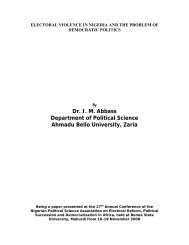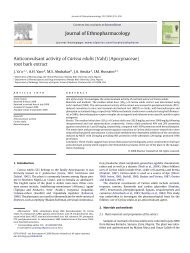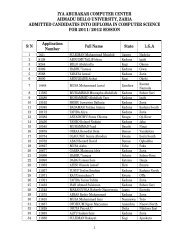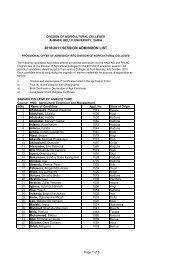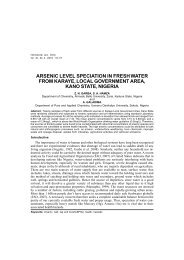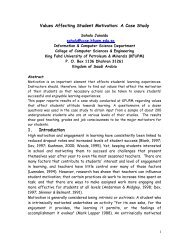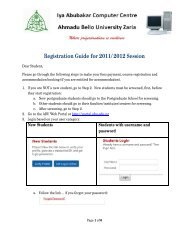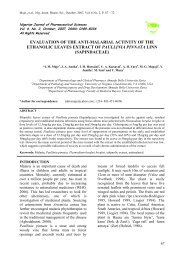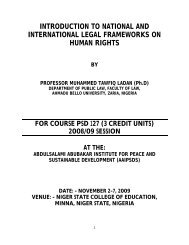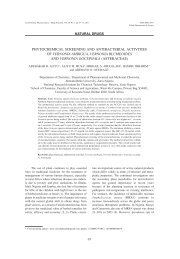Hypotensive Effect of Aqueous Seed Extract of Hibiscus sabdariffa ...
Hypotensive Effect of Aqueous Seed Extract of Hibiscus sabdariffa ...
Hypotensive Effect of Aqueous Seed Extract of Hibiscus sabdariffa ...
You also want an ePaper? Increase the reach of your titles
YUMPU automatically turns print PDFs into web optimized ePapers that Google loves.
shaker. The supernatant liquid (extract) was filtered<br />
through a plug <strong>of</strong> cotton or glass wool. The process was<br />
repeated for complete extraction. The extracts were then<br />
poured into evaporating dish to evaporate the solvent in<br />
the extract over the water bath at the temperature <strong>of</strong> 40ºC<br />
- 45ºC (Abdul, 1990).<br />
Int. J. Anim. Sci. Veter. Adv., 2(1): 5-8, 2010<br />
Experimental design: The experiment was an in vivo and<br />
two cats were used. The cat was anesthetized by injecting<br />
Thiopentane sodium via intraperitoneal route. The animal<br />
lost consciousness after 20 minutes <strong>of</strong> administration,<br />
after which it was properly secured to the dissecting table<br />
by using twine to tie its limbs, so as to prevent unwanted<br />
movement <strong>of</strong> the animal during the experiment. The left<br />
femoral vein was exposed and tied with peripheral<br />
ligature. Also, the right carotid artery was exposed and<br />
cannulated for blood pressure measurement. The basal<br />
blood pressure was recorded on a filter paper <strong>of</strong> the<br />
micro-dynamometer after the administration <strong>of</strong> the<br />
heparinized normal saline to prevent blood clothing. The<br />
drugs and extract were administered through the cannula<br />
inserted through the left femoral vein. The speed and<br />
sensitivity <strong>of</strong> the machine were 95mm/minute and 1<br />
respectively. The first set <strong>of</strong> drugs recorded were the<br />
standard drugs (Ach and Adrenaline), followed by graded<br />
dose response for each extract, and the dose which caused<br />
maximum effect was chosen as experimental dose.<br />
Flushing was properly done after every administration <strong>of</strong><br />
extract and drugs till it was brought back to normal.<br />
Phytochemical Analysis: The aqueous seed extract <strong>of</strong><br />
<strong>Hibiscus</strong> <strong>sabdariffa</strong> l. were subjected to preliminary<br />
phytochemical screening, to identify the chemical<br />
constituents. The methods <strong>of</strong> analysis employed were<br />
those described by Brain and Turner (1975).<br />
Acute toxicity study: The lethal dose (LD50) <strong>of</strong> the plant<br />
extract was determined by the method <strong>of</strong> Lorke (1983)<br />
using 13 rats. In the first phase rats were divided into 3<br />
groups <strong>of</strong> 3 rats each and were treated with the aqueous<br />
extract <strong>of</strong> the seed at doses <strong>of</strong> 10, 100 and 1000 mg/kg<br />
body weight intraperitoneal. They were observed for 24<br />
h for signs <strong>of</strong> toxicity. In the second phase 4 rats were<br />
divided into 4 groups <strong>of</strong> 1 rat each and were also treated<br />
with the aqueous extract at doses <strong>of</strong> 1000, 1600, 2900 and<br />
5000 mg/kg bodyweight (i.p). The median lethal dose<br />
(LD50) was calculated using the second phase.<br />
Statistical Analysis: All data are expressed as Mean ±<br />
S.E.M. The data obtained were analyzed using one way<br />
analysis <strong>of</strong> variance (ANOVA) and Turkey-Kramer post<br />
hoc test for multiple comparisons. The (P


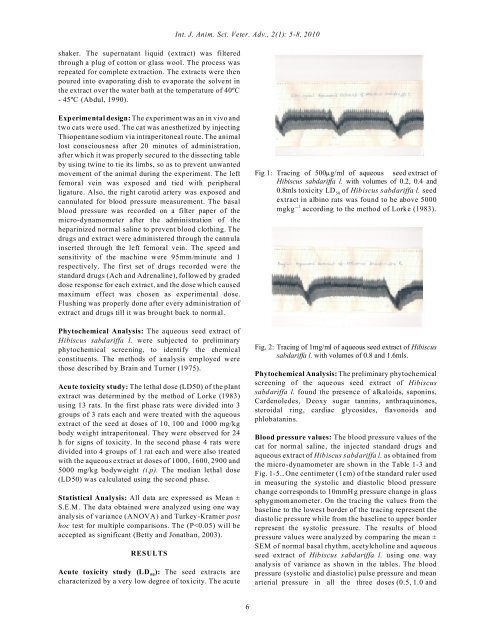
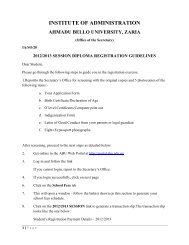
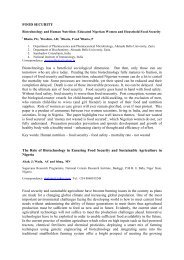
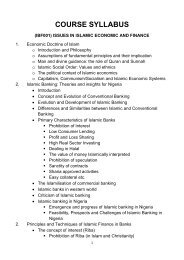
![Full Paper [PDF]](https://img.yumpu.com/49740055/1/184x260/full-paper-pdf.jpg?quality=85)
